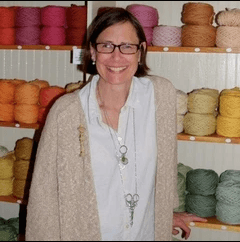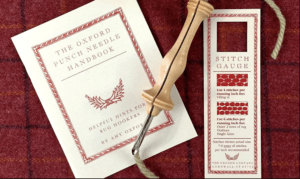By: Cladwell
Amy Oxford is the founder of The Oxford Company, and the inventor of the Oxford Punch Needle. This year is the 25th anniversary of the Oxford Punch Needle. Punch needle rug hooking is a specific technique for making rugs. The style describes a technique in which the needle punches the loops down into the work, as opposed to other styles of rug hooking which use a different type of tool to pull the loops up through the work. These two techniques can be used to form the same type of stitch using slightly different actions.
The Oxford Company’s website explains that “the Oxford Punch Needle forms a continuous loop stitch. Every time you push The Oxford Punch Needle down, it pushes down a long end of yarn. When you bring The Oxford Punch Needle back up, it folds this end into a loop. There are no knots used. The tightness of all the loops packed together keeps it from unraveling.”
This style has been in Amy Oxford’s wheelhouse since 1982, when she was first trained as a rug hooker in North Bennington, Vermont. She began teaching in 1986 and has continued to be involved ever since. After becoming a teacher, she discovered a lack of places for people to buy supplies, so she opened her first shop and mail order business. In 1995, she invented the Oxford Punch Needle. Amy’s passion for her craft is evident.
Throughout her years in the industry, Amy has experienced being a student, a teacher, a store owner, an inventor, a speaker, a mentor, an award winner, and many other roles. We had the opportunity to connect with her to discuss her journey thus far, with both the Oxford Company and her previous endeavors, as well as what is on the horizon!

What drew you to punch needle style hooked rugs? What was the inspiration for starting your own company?
I had a small weaving business making handwoven textiles but when my friends Cynthia and Preston McAdoo took over Preston’s parent’s business, McAdoo Rugs, I saw Preston’s first prototype and knew I had to learn how to “punch!” The medium offered everything I loved about weaving. The warmth and beauty of wool, rich colors, and textures but I was especially excited about the design possibilities. The technique is like painting with wool. I asked for a job on the spot and worked for them making their rugs in my home.
McAdoo Rugs was asked to send someone to teach a class at a nearby craft center but no one wanted to go, least of all me. I was chosen because I lived the closest to the school and to my surprise, it turned out that I loved teaching! My students wanted to know where they could get supplies and at the time (1985) there was only one punch needle supply shop in the country. I knew I wanted to keep teaching so I opened my first business, Red Clover Rugs. I sold patterns, supplies, kits, and sold rugs in galleries and on commission. My inspiration was my love for the craft and seeing how much others enjoyed it too. It’s quick, easy, and forgiving. One student described it as “instant gratification with wool.”
What was one of your most notable challenges in this process?
There were multiple challenges, the largest being changing a stereotype that the craft was inferior to an earlier style of rug hooking called traditional rug hooking. I had to prove that the craft was just as worthy of respect. I encouraged my students to use high quality materials, excellent technique, and creative artistry to help to elevate the craft. The thrilling part is that punch is now highly regarded and recognized as the art form it deserves to be.
After thousands of hours of rug making, often working 10-12 hours at a time on commissions, I developed carpal tunnel syndrome and tendinitis in my elbow and had to take a year off. I worked with an engineer to help me create an ergonomic tool that would help prevent repetitive motion injuries and The Oxford Punch needle was born.
Then there was the time mice nibbled 14 little holes in a custom order that was almost finished… And the time I delivered a commission and the owner’s dog chewed a hole in it the size of my head…
How has the addition of the Oxford Rug Hooking School impacted the company?
After traveling to teach for 26 years, I welcome being able to teach a few miles from home. Students come from all over the world and it’s wonderful to be able to share the craft with them. Before we opened the school, we were mail order only but now we have a shop here as well.

What is one of your biggest accomplishments from your journey with The Oxford Company thus far?
Surviving being discovered on social media! In 2017 an Instagram influencer, Arounna Khounnoraj posted a video using my tool. The video went viral overnight. We sold out instantly, made 2000 more and sold out in a few hours. Sales grew 460%. One of the main reasons small businesses go under is due to rapid growth and I was determined to stay afloat without compromising my high standards for my handmade tool. (We assemble them all ourselves.) Not compromising quality with the demand for quantity was essential to protect our brand.
Share a project of The Oxford Company, either past present or future, that you are especially proud of.
I started The Oxford Punch Needle Teacher Certification program in 1994. We now have 114 Oxford Certified Oxford Instructors in the US, Canada, the UK, Ireland, and Germany.
What role do you feel Intellectual Property has played in the success of The Oxford Company?
When my tool went viral, I was sure it would be copied by opportunists. I was correct. My patents and trademark give me confidence that I will be protected. I hope to sell my punch needle business when I retire and having IP adds value to my product and respect for my brand.
What is a lesson you have learned from working with patent attorneys?
It was vital for me to have someone I could trust who I knew would look out for the little guy as much as a major corporation. I didn’t think I’d be able to get a patent and I got two. Lesson learned: it’s worth every penny to get the best patent attorney in your corner.

What is your personal favorite pattern you have ever created? Which has the most interesting story attached to it?
I loved making this stair runner (pictured above) for a family in Victor, NY. It tells the history of the family, starting with the parent’s birth places, Rochester, NY and Philadelphia, working up to the present. There was a riser for each son, childhood horses, beloved dogs, a graduation, wedding, house raising, canoe trips, and other family memories. The runner was made in three sections and is 18” wide and 24’ long.
The client gave me the measurement of the stairs and I was set to start drawing the next day but woke up in a cold sweat thinking, “What if the runner doesn’t fit?” I drove 12 hours with a roll of brown paper and made a pattern of the stairs, marking each tread and riser. Thank goodness I did, otherwise the runner would have been much too short. It takes extra length to wrap around the lip of each step. This took 6 months to punch with the help of three assistants.
What is next for The Oxford Company?
We have had to close the school for 2020 due to COVID-19 which is sad for us and our students. We’re incredibly fortunate that sales of Oxford Punch Needles have gone up as people look for a restful and creative hobby during quarantine. We’re lucky because our mill that turns our wood handles is “essential” and the tool and dye company that makes our metal needle is “essential critical” because they also make parts for hospital equipment so we’ve been able to keep manufacturing.
This year marks the 25th anniversary of The Oxford Punch Needle and we’re looking forward to putting out some limited edition, multi-colored blue and green wood handles. Mostly we are just thankful to be able to stay in business during these difficult times and catching our breath, looking for ways to give back to our community.